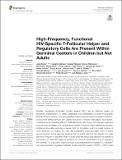| dc.contributor.author | Roider, Julia | |
| dc.contributor.author | Maehara, Takashi | |
| dc.contributor.author | Ngoepe, Abigail | |
| dc.contributor.author | Ramsuran, Duran | |
| dc.contributor.author | Muenchhoff, Maximilian | |
| dc.contributor.author | Adland, Emily | |
| dc.contributor.author | Jooste, Pieter | |
| dc.contributor.author | Karim, Farina | |
| dc.contributor.author | Kuhn, Warren | |
| dc.contributor.author | Ndung'u, Thumbi | |
| dc.contributor.author | Morris, Lynn | |
| dc.contributor.author | Moore, Penny L. | |
| dc.contributor.author | Kløverpris, Henrik | |
| dc.contributor.author | Goulder, Philip | |
| dc.contributor.author | Leslie, Alasdair | |
| dc.contributor.author | Aicher, Toby Paul | |
| dc.contributor.author | Kazer, Samuel Weisgurt | |
| dc.contributor.author | Shalek, Alexander K | |
| dc.contributor.author | Pillai, Shiv | |
| dc.date.accessioned | 2018-10-23T12:14:30Z | |
| dc.date.available | 2018-10-23T12:14:30Z | |
| dc.date.issued | 2018-09 | |
| dc.date.submitted | 2018-06 | |
| dc.identifier.issn | 1664-3224 | |
| dc.identifier.uri | http://hdl.handle.net/1721.1/118748 | |
| dc.description.abstract | Broadly neutralizing antibodies (bnAbs) against HIV-1 are an effective means of preventing transmission. To better understand the mechanisms by which HIV-specific bnAbs naturally develop, we investigated blood and lymphoid tissue in pediatric infection, since potent bnAbs develop with greater frequency in children than adults. As in adults, the frequency of circulating effector T-follicular helper cells (TFH) in HIV infected, treatment naïve children correlates with neutralization breadth. However, major differences between children and adults were also observed both in circulation, and in a small number of tonsil samples. In children, TFHcells are significantly more abundant, both in blood and in lymphoid tissue germinal centers, than in adults. Second, HIV-specific TFHcells are more frequent in pediatric than in adult lymphoid tissue and secrete the signature cytokine IL-21, which HIV-infected adults do not. Third, the enrichment of IL-21-secreting HIV-specific TFHin pediatric lymphoid tissue is accompanied by increased TFHregulation via more abundant regulatory follicular T-cells and HIV-specific CXCR5+ CD8 T-cells compared to adults. The relationship between regulation and neutralization breadth is also observed in the pediatric PBMC samples and correlates with neutralization breadth. Matching neutralization data from lymphoid tissue samples is not available. However, the distinction between infected children and adults in the magnitude, quality and regulation of HIV-specific TFHresponses is consistent with the superior ability of children to develop high-frequency, potent bnAbs. These findings suggest the possibility that the optimal timing for next generation vaccine strategies designed to induce high-frequency, potent bnAbs to prevent HIV infection in adults would be in childhood. | en_US |
| dc.publisher | Frontiers Research Foundation | en_US |
| dc.relation.isversionof | http://dx.doi.org/10.3389/fimmu.2018.01975 | en_US |
| dc.rights | Creative Commons Attribution 4.0 International License | en_US |
| dc.rights.uri | http://creativecommons.org/licenses/by/4.0/ | en_US |
| dc.source | Frontiers | en_US |
| dc.title | High-Frequency, Functional HIV-Specific T-Follicular Helper and Regulatory Cells Are Present Within Germinal Centers in Children but Not Adults | en_US |
| dc.type | Article | en_US |
| dc.identifier.citation | Roider, Julia, Takashi Maehara, Abigail Ngoepe, Duran Ramsuran, Maximilian Muenchhoff, Emily Adland, Toby Aicher, et al. “High-Frequency, Functional HIV-Specific T-Follicular Helper and Regulatory Cells Are Present Within Germinal Centers in Children but Not Adults.” Frontiers in Immunology 9 (September 12, 2018). | en_US |
| dc.contributor.department | Institute for Medical Engineering and Science | en_US |
| dc.contributor.department | Harvard University--MIT Division of Health Sciences and Technology | en_US |
| dc.contributor.department | Massachusetts Institute of Technology. Department of Chemistry | en_US |
| dc.contributor.mitauthor | Aicher, Toby Paul | |
| dc.contributor.mitauthor | Kazer, Samuel Weisgurt | |
| dc.contributor.mitauthor | Shalek, Alexander K | |
| dc.contributor.mitauthor | Pillai, Shiv | |
| dc.relation.journal | Frontiers in Immunology | en_US |
| dc.eprint.version | Final published version | en_US |
| dc.type.uri | http://purl.org/eprint/type/JournalArticle | en_US |
| eprint.status | http://purl.org/eprint/status/PeerReviewed | en_US |
| dc.date.updated | 2018-10-22T19:38:06Z | |
| dspace.orderedauthors | Roider, Julia; Maehara, Takashi; Ngoepe, Abigail; Ramsuran, Duran; Muenchhoff, Maximilian; Adland, Emily; Aicher, Toby; Kazer, Samuel W.; Jooste, Pieter; Karim, Farina; Kuhn, Warren; Shalek, Alex K.; Ndung'u, Thumbi; Morris, Lynn; Moore, Penny L.; Pillai, Shiv; Kløverpris, Henrik; Goulder, Philip; Leslie, Alasdair | en_US |
| dspace.embargo.terms | N | en_US |
| dc.identifier.orcid | https://orcid.org/0000-0002-7380-9594 | |
| dc.identifier.orcid | https://orcid.org/0000-0001-5670-8778 | |
| mit.license | PUBLISHER_CC | en_US |
